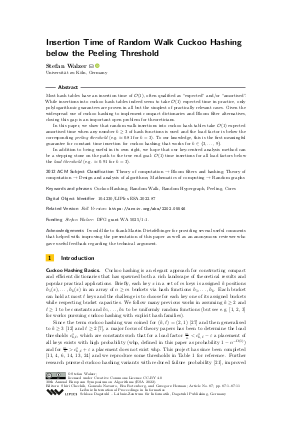@InProceedings{walzer:LIPIcs.ESA.2022.87,
author = {Walzer, Stefan},
title = {{Insertion Time of Random Walk Cuckoo Hashing below the Peeling Threshold}},
booktitle = {30th Annual European Symposium on Algorithms (ESA 2022)},
pages = {87:1--87:11},
series = {Leibniz International Proceedings in Informatics (LIPIcs)},
ISBN = {978-3-95977-247-1},
ISSN = {1868-8969},
year = {2022},
volume = {244},
editor = {Chechik, Shiri and Navarro, Gonzalo and Rotenberg, Eva and Herman, Grzegorz},
publisher = {Schloss Dagstuhl -- Leibniz-Zentrum f{\"u}r Informatik},
address = {Dagstuhl, Germany},
URL = {https://drops.dagstuhl.de/entities/document/10.4230/LIPIcs.ESA.2022.87},
URN = {urn:nbn:de:0030-drops-170250},
doi = {10.4230/LIPIcs.ESA.2022.87},
annote = {Keywords: Cuckoo Hashing, Random Walk, Random Hypergraph, Peeling, Cores}
}

 Creative Commons Attribution 4.0 International license
Creative Commons Attribution 4.0 International license
